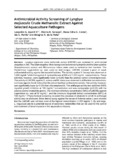Antimicrobial activity screening of Lyngbya majuscula crude methanolic extract against selected aquaculture pathogens
Share
Abstract
Lyngbya majuscula crude methanolic extract (LMCME) was screened for antimicrobial properties in vitro. The Gram-negative Vibrio harveyi and Aeromonas hydrophila and the Gram-positive Staphylococcus aureus and Micrococcus luteus were used as reference test bacteria. The filamentous Lagenidium sp. was used as test fungus. LMCME showed a poor or weak antibacterial activity against the bacterial isolates. The activity against V. harveyi was observed at 1,000 mg/mL-1 while that against A. hydrophila was at 500 and 1,000 mg/mL-1 concentrations. These activities, however, were significantly lower (p<0.05) than the positive control (chloramphenicol). The activity of LMCME against S. aureus and M. luteus was observed in all the test concentrations, but it was against the M. luteus that the extract had high antibacterial activity. This activity, however, was significantly lower (p<0.05) than chloramphenicol. The antifungal activity test exhibited 100% mycelial growth inhibition at 100 mg/mL-1 concentration and was comparable (p>0.05) with the positive control (malachite green). The minimum inhibitory concentration (MIC) of LMCME against Lagenidium sp. was at 50 mg/mL-1, and the minimum fungicidal (lethal) concentration (MFC) at 100 mg/mL-1. Phytochemical screening revealed the presence of alkaloids to which its antifungal activity may be attributed. Brine shrimp assay against the larvae of Artemia salina L each showed that the LMCME was not toxic even at the highest concentration (1,000 mg/mL-1). By and large, L. majuscula can be a potential source of secondary metabolites that can be used for the control and treatment of larval mycosis in the aquaculture industry.
Suggested Citation
Ayukil, L. G., III, Seraspe, E. B., Corda, D. E. G., Pahila, I. G., & de la Peña, M. R. (2010). Antimicrobial activity screening of Lyngbya majuscula crude methanolic extract against selected aquaculture pathogens. Philippine Journal of Natural Sciences , 15(2), 89-100. http://hdl.handle.net/10862/3098
Subject
Taxonomic term
Koleksi
- AQD Journal Articles [1215]



